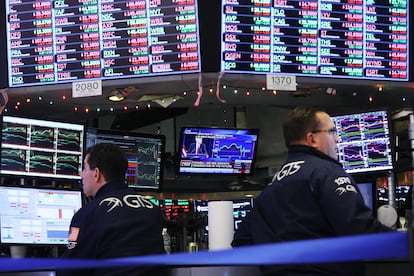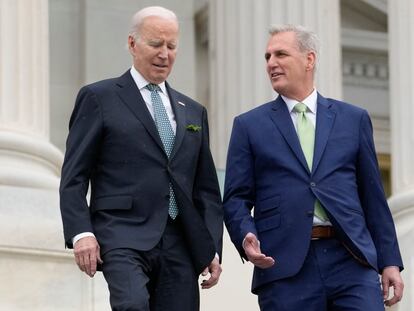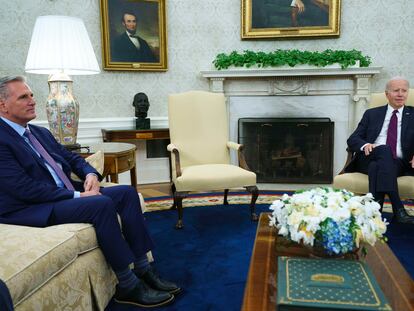How will the US debt ceiling crisis affect investment?
Without a political agreement between the Republicans and Democrats, the risk of default looms large, while shocks are guaranteed across the global market. Financial experts are advising clients to buy gold and keep cash on hand

Republicans and Democrats are negotiating to approve an increase in the debt ceiling – a necessary measure to prevent the federal government from defaulting. The inability to reach an agreement has caused anxiety among investors in recent weeks.
With the 2024 presidential elections on the horizon, a matter of economic stability has turned into a full-fledged political battle. The Republicans are attempting to weaken President Joe Biden as much as possible – even at the risk of putting the servicing of US debt at stake. The financial implications of this are very real; they’re already being felt across the global market.
There is newfound uncertainty about whether Republicans and Democrats will reach an agreement in time. If the negotiations aren’t finalized by the start of June, the US Treasury will be unable to borrow more. This would exacerbate already-existing concerns about a recession in the world’s largest economy. Understandably, this is contributing to investor pessimism, both domestically and internationally.
The price of credit default insurance (CDS) on US sovereign debt is the highest ever in this early phase of the debt limit negotiation. What happens in the coming days is going to be key: either it will put an end to this year’s stock market rally, or, if the risk of default is cleared, money will re-enter the market in search of investment opportunities.
Is there a real risk of default in the US? Why is the debate over the debt ceiling being watched so closely?
The general opinion among investors is that a political agreement to avoid default will ultimately be reached… even if it’s at the last minute. For Goldman Sachs, “the most likely [outcome] is a full-fledged deal that suspends the debt limit to early 2025, along with spending caps.” But this drawn-out negotiation may have caused notable wear and tear on the price of American assets. The US has only defaulted once – in 1979 – fleetingly and for technical reasons, although uncertainty about the debt ceiling took a serious toll on the country’s fiscal solvency in 2011. The political agreement reached that year between the House Republicans and President Obama did not prevent S&P from lowering the US rating for the first time in its history. That year, the credit rating agency withdrew America’s triple-A credit score – the highest possible rating that may be assigned to an issuer’s bonds.
During that same period, the S&P 500 – a market-capitalization-weighted index of 500 leading publicly traded companies in the US – fell by 17% over the course of 22 days, while the VIX Index – a measure of expected volatility in the US stock market – tripled, hitting a score of 48.
Is the current tension comparable to the 2011 debt ceiling debate?
The countdown to an agreement on the debt ceiling in 2011 – which failed to prevent a ratings downgrade – coincided with the start of the sovereign debt crisis in Europe, which ended up destabilizing the global market. However, in 2023, investors are even more concerned about US sovereign debt. The spread between the one-month and five-year Treasuries remains near an all-time high of about 235 basis points. Given the new risks, the cost of insuring against default on US sovereign debt has also reached multi-decade highs, with a one-year CDS hovering around 150 basis points… up from 14 at the beginning of 2023. This is well above the levels of the 2011 debt ceiling crisis.
The US listed companies that have close ties to the federal government are also showing poor performance on the S&P 500, with a 10% overall drop in market value. Anticipating a cut in public spending post-negotiations, Goldman Sachs points out that the healthcare and defense sectors – which rely heavily on government contracts – are most at risk.
What precautions should investors take?
George Brown – an economist at Schroders Investment Management – advises that investors “wait for success, but be prepared for failure.” The general expectation of the market is that there will finally be an agreement that avoids default… but as a precautionary measure, Brown points out that, to the extent possible, “portfolios should be liquid and diversified, to guarantee that capital can be reallocated quickly, given the volatility seen during previous episodes of debt ceiling manipulation.”
The economist also recommends putting a high value on gold – despite the recent rally that has already taken it to new highs – and triple-A sovereign debt issues, such as Germany’s (countries at the lowest risk of default). “We expect safe haven currencies – such as the Japanese yen and Swiss franc – to do well against the US dollar,” he adds.
Chris Iggo – investment director of AXA Investment Managers – is clear that “a US debt default would be a huge shock to the global financial system, which would probably cause increased volatility, a weakening of the dollar, the evaporation of liquidity in the money market and a stock market crash.” Not surprisingly, what’s at stake is the confidence that investors have in the US government. A default – however small or symbolic – could damage that confidence “for a long time.” For Iggo, the “repercussions would be global – both for bond yields and for the US dollar.”
As Dennis Shen – director of public sector and sovereign ratings at Scope Ratings – recalls, “the technical default of 1979 debunked the idea that debt ceiling problems are always resolved on time.” If there is no agreement by the beginning of June – and given the foreseeable volatility of the market and the deterioration of growth prospects – the Fed could be forced to cut interest rates to stimulate borrowing and investment, as contemplated by AXA.
What will be the market reaction to an agreement? And what investment opportunities would such a scenario present?
For Brown, investors who are willing to trust that the US Congress will succeed in raising the debt ceiling in time can either hold onto their Treasury bills, or consider selling them now – while prices are high – and reinvest in bills that will mature sooner, so they can be repaid their principal faster.
“The key to [this investment strategy] will be getting the timing right, when concerns about the debt ceiling reach a fever pitch. We haven’t reached that stage yet, but it shouldn’t be far off,” he says.
Upon an agreement being reached, the US Treasury would trigger the issuance of bills, which will help the institution restock its coffers. Bank of America warns that the subsequent decline in the profitability of T-bills will direct investors to other assets, as they seek higher yields.
Sign up for our weekly newsletter to get more English-language news coverage from EL PAÍS USA Edition
Tu suscripción se está usando en otro dispositivo
¿Quieres añadir otro usuario a tu suscripción?
Si continúas leyendo en este dispositivo, no se podrá leer en el otro.
FlechaTu suscripción se está usando en otro dispositivo y solo puedes acceder a EL PAÍS desde un dispositivo a la vez.
Si quieres compartir tu cuenta, cambia tu suscripción a la modalidad Premium, así podrás añadir otro usuario. Cada uno accederá con su propia cuenta de email, lo que os permitirá personalizar vuestra experiencia en EL PAÍS.
¿Tienes una suscripción de empresa? Accede aquí para contratar más cuentas.
En el caso de no saber quién está usando tu cuenta, te recomendamos cambiar tu contraseña aquí.
Si decides continuar compartiendo tu cuenta, este mensaje se mostrará en tu dispositivo y en el de la otra persona que está usando tu cuenta de forma indefinida, afectando a tu experiencia de lectura. Puedes consultar aquí los términos y condiciones de la suscripción digital.











































